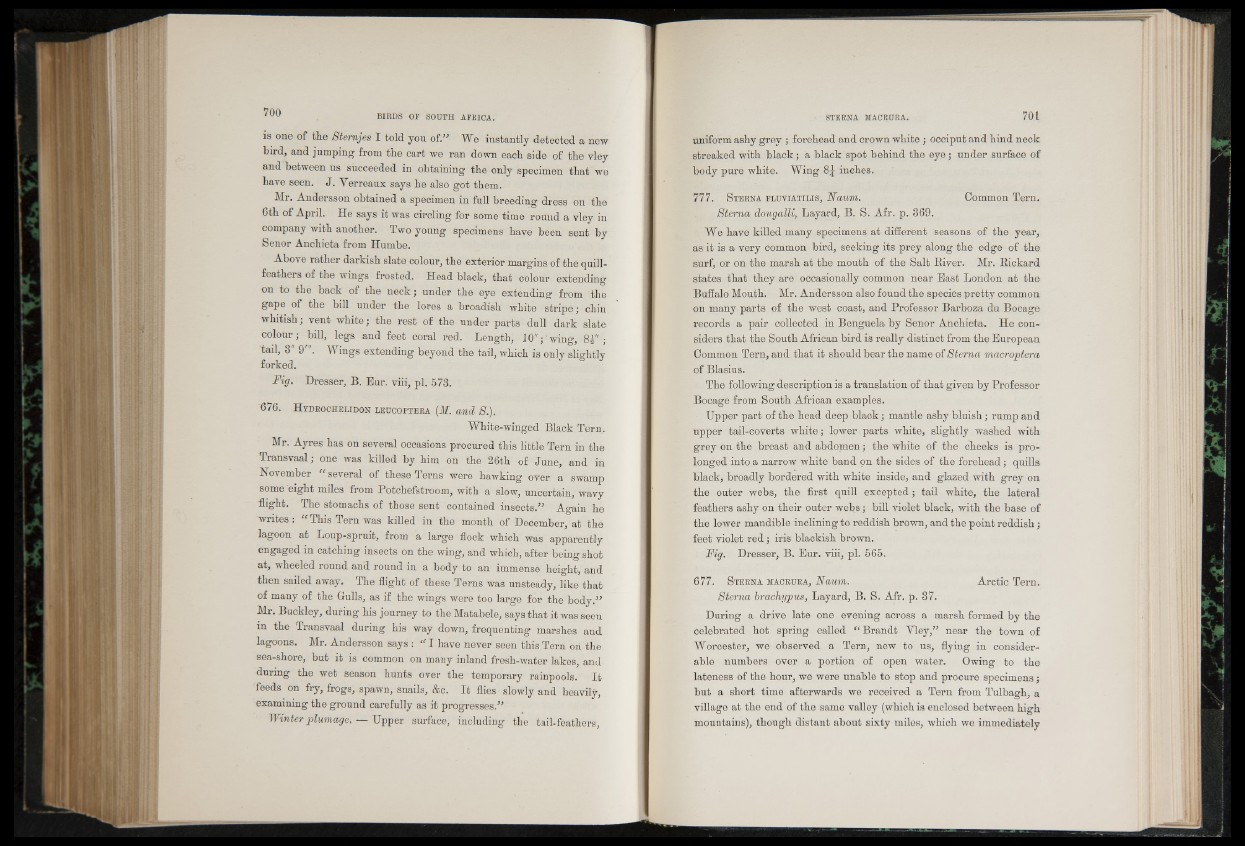
is one of the Stemjes I told you of.” We instantly detected a new
bird, and jumping from the cart we ran down each side of the vley
and between us succeeded in obtaining the only specimen that we
have seen. J. Verreaux says he also got them.
Mr. Andersson obtained a specimen in full breeding dress on the
6th of April. He says it was circling for some time round a vley in
company with another. Two young specimens have been sent by
Senor Anchieta from Humbe.
Above rather darkish slate colour, the exterior margins of the quill-
feathers of the wings frosted. Head black, that colour extending
on to the back of the neck; under the eye extending from the
gape of the bill under the lores a broadish white stripe; chin
whitish; vent white; the rest of the under parts dull dark slate
colour; bill, legs and feet coral red. Leugth, 10"; wing, 81" ;
tail, 3" 9"'. Wings extending beyond the tail, which is onlv sliahtlv
forked.
Fig. Dresser, B. Bur. viii, pi. 573.
676. H y drochelidon leucoptera ( I f . and S.).
White-winged Black Tern.
Mr. Ayres has on several occasions procured this little Tern in the
Transvaal; one was killed by him on the 26th of June, and in
November “ several of these Terns were hawking over a swamp
some eight miles from Potchefstroom, with a slow, uncertain, wavy
flight. The stomachs of those sent contained insects.” Again he
writes: “ This Tern was killed in the month of December, at the
lagoon at Loup-spruit, from a large flock which was apparently
engaged in catching insects on the wing, and which, after being shot
at, wheeled round and round in a body to an immense height, and
then sailed away. The flighrof these Terns was unsteady, like that
of many of the Gulls, as if the wings were too large for the body.”
Mr. Buckley, during his journey to the Matabele, says that it was seen
in the Transvaal during his way down, frequenting marshes and
lagoons. Mr. Andersson says : “ I have never seen this Tern on the
sea-shore, but it is common on many inland fresh-water lakes, and
during the wet season hunts over the temporary rainpools. It
feeds on fry, frogs, spawn, snails, &c. It flies slowly and heavily,
examining the ground carefully as it progresses.”
Winter plumage. — Upper surface, including the tail-feathers,
uniform ashy grey ; forehead and crown white; occiput and hind neck
streaked with black; a black spot behind the eye; under surface of
body pure white. Wing 8J inches.
777. S terna f lu v ia t il is , Navm. Common Tern.
Sterna dougalli, Layard, B. S. Afr. p. 369.
We have killed many specimens at different seasons of the year,
as it is a very common bird, seeking its prey along the edge of the
surf, or on the marsh at the mouth of the Salt River. Mr. Rickard
states that they are occasionally common near Bast London at the
Buffalo Mouth. Mr. Andersson also found the species pretty common
on many parts of the west coast, and Professor Barboza du Bocage
records a pair collected in Benguela by Senor Anchieta. He considers
that the South African bird is really distinct from the European
Common Tern, and that it should bear the name of Sterna macroptera
of Blasius.
The following description is a translation of that given by Professor
Bocage from South African examples.
Upper part of the head deep black; mantle ashy bluish; rump and
upper tail-coverts white; lower parts white, slightly washed with
grey on the breast and abdomen; the white of the cheeks is prolonged
into a narrow white band on the sides of the forehead; quills
black, broadly bordered with white inside, and glazed with grey on
the outer webs, the first quill excepted; tail white, the lateral
feathers ashy on their outer webs; bill violet black, with the base of
the lower mandible inclining to reddish brown, and the point reddish;
feet violet red; iris blackish brown.
Fig. Dresser, B. Eur. viii, pi. 565.
677. S terna macrura, Naum. Arctic Tern.
Sterna brachypus, Layard, B. S. Afr. p. 37.
During a drive late one evening across a marsh formed by the
celebrated hot spring called “ Brandt Vley,” near the town of
Worcester, we observed a Tern, new to us, flying in considerable
numbers over a portion of open water. Owing to the
lateness of the hour, we were unable to stop and procure specimens;
but a short time afterwards we received a Tern from Tulbagh, a
village at the end of the same valley (which is enclosed between high
mountains), though distant about sixty miles, which we immediately